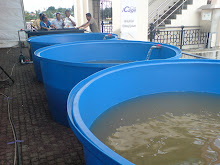Pond culturing of tilapia has been going on since the Ancient Egyptians started to keep tilapias in ponds along the Nile thousands of years ago, but during the 20th century tilapia farmers have been given two new alternatives to ponds: tank culturing and cage culturing. Tank culturing is most commonly utilized in areas where there is a shortage of suitable land and/or water. As long as you keep the water quality up, it is possible to grow tilapia in really high densities in tanks.
Advantages and disadvantages of tanks compared to ponds
Advantages
* It is easier to meticulously control the environment in a tank than in a pond, e.g. when it comes to water temperature, pH-level and oxygen content. When tilapia can be more densely stocked thanks to optimal water conditions, even small parcels of land can yield large harvests.
* It is also easier to keep the tank free from birds and snails compared to a pond. Birds and snails can harbour parasites capable of infesting tilapia fish.
* Feeding and harvesting is typically less labour intensive in tanks than in ponds.
* In ponds where both male and female tilapia is kept, uncontrolled breeding can easily turn into a problem. When tilapias are stocked in high density in tanks, the natural breeding behaviour is disrupted. The adult fish can put more energy into growing when they do not have to compete for food with their offspring.
Disadvantages
* Pond grown tilapia can make use of naturally occurring food, while tank grown tilapia has no access to a natural food source and has to be fed by you to a much higher extent. The food that you give your tank grown tilapia has to be complete, e.g. contain the proper amounts of all necessary vitamins and minerals.
* When tilapia is grown in tanks, most farmers opt for a high stocking density. A high stocking density creates a stressful environment for the fish and the risk of ill health is therefore high. The risks will be increased further if the farmer fails to provide the fish with optimal water conditions and a satisfactory diet.
* In order to strictly control the environment in the tank, you have to use really efficient pumps and aeration equipment which can be costly to purchase and use. Recirculation systems also require a substantial investment and must be properly managed. All sorts of equipment that needs electricity will stop working during power outages and this can lead to mass deaths if you do not have a back-up system. (It should however be noted that many pond farmers use mechanical equipment too, it is not something that is limited to tank cultures only.)
Choosing species
The perfect species or hybrid for tank raising will depend on several factors, such as climate and availability. It is also important to remember that many countries have bans against certain species and hybrids. A few examples of tilapia species that are popular among tank keepers are Nile tilapia (Oreochromis niloticus), Blue tilapia (Oreochromis aureus ) and the manmade tilapia forms Florida Red and Taiwan Red. Blue tilapia grows fairly slow, but is on the other hand one of the most cold tolerant species of tilapia. Nile tilapia grows much faster, but only when kept in tropical conditions. Florida Red and Taiwan Red have a well-liked reddish colour.
Water quality
If you want to be able to keep densely stocked cages, proper water management is of imperative importance. Two key elements in tilapia water management is aeration and waste removal. This is normally achieved through continuous or frequent water changes, since this will dilute waste as well as provide the water with dissolved oxygen (DO). Some systems will discard the used water, while others filter the water and recycle it over and over again. The first type of system is called flow-through system while the other type is known as recirculation system or recirculating system.
The choice of system will in part depend on the climate. In tropical parts of the world, tilapia can be grown outdoors year round. In colder areas, the growing season will be shorter unless the water is heated. Discarding heated water and replacing it with new is very expensive in the long run, and flow-through systems are therefore uncommon outside the tropics. They are however used in non-tropic regions where geothermal water or other types of inexpensive hot water is available. Surplus water from power plants is an interesting alternative that is being tried in several parts of the world. For most localities, recirculation systems are however still the most feasible solution for those interested in cultivating tilapia year round outside the tropics. Indoor systems are popular, since an isolated building will conserve heat.
Temperature
The recommended water temperature for tilapia is 28-30 degrees C (82-86 degrees F). The growth rate will decrease dramatically if the water is colder than 20 degrees C (50 degrees F) and fishes will normally start dying at roughly 10 degrees C (50 degrees F). It is also important to remember that cold water will affect the immune system of the fish and make it more prone to ill health. A water temperature below 13 degrees C (55 degrees F) is therefore never advisable
Subscribe to:
Post Comments (Atom)









No comments:
Post a Comment